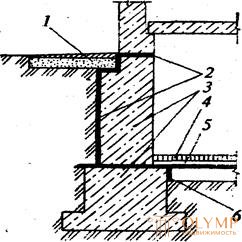
Brick, concrete and other building materials absorb and retain water in the pores. Due to the capillary suction, the water in the structures can rise to a considerable height.
Moisture-saturated materials lose strength and other important performance qualities, and the presence of salts in moisture leads to the destruction of these materials and structures.
Work on the protection of structures from the penetration of moisture in them is called waterproofing, and a layer of waterproof materials on the enclosing surface - waterproofing. At the location in space, waterproofing can be underground, underwater and above ground, relative to the insulated building - external or internal.
By appointment, waterproofing is divided into sealing , heat - insulating, anti-corrosion and anti-filtration.
Waterproofing is performed to protect the underground parts of buildings and structures from the penetration of groundwater and prevent the capillary leakage of moisture (Fig. 19.1), creating an impermeability of the storage of various liquids from the effects of corrosive waters.
Fig. 19.1. Foundation waterproofing from capillary moisture: 1-blind area; 2- cement plaster; 3-anti-capillary gasket; 4- okra-juicy waterproofing; 5-security fence; 6-foundation; 7-waterproofing deformation seam; 8- concrete preparation; 9- cement watertight screed; 10 - loading plate | In residential and civil buildings, the foundations, walls and floors of basements, the floors of the first floors of baseless buildings, the floors and walls of sanitary facilities and bathrooms are waterproofed. In industrial buildings and structures, waterproofing and walls of workshops with wet processes, junctions, tunnels and underground stations, tanks, wells, and pitches are subjected to waterproofing. The following main types of waterproofing are distinguished : painting, pasting (from roll and film materials), plastering (including gunite), asphalt and composite (from metal and polymer sheets and profiles). Casting (insulating material is poured over an insulated surface or filling gaps), impregnating (impregnating porous materials), filling (from hydrophobic powders) and injection (injection into |
soil, cracks and cracks waterproofing material).
By constructive solution, waterproofing can be single-layered, reinforced and unreinforced, with and without a protective layer, ventilated, when the sub-cover space communicates with the outside air.
The type of waterproofing taken depends on the required quality, durability, and existing groundwater retention.
When choosing a waterproofing, the required dryness and crack resistance of structures are taken into account. Those materials which are most fully selected
meet the requirements for waterproofing, ways
comparison of their characteristics with operating conditions.
Surface preparation . Before applying waterproofing perform preparatory processes. Initially, at the site where they will perform waterproofing work, they carry out a reduced level of groundwater to a mark not less than 50 cm below the lower mark of waterproofing. Next, carry out the preparation of surfaces for applying a waterproofing coating. For different types of bases, the preparatory processes are different.
For surfaces made of concrete structures produce:
• cleaning the surface from dirt;
• removal of mounds and other irregularities;
cutting the protruding ends of the reinforcement;
• Seal recesses and sinks with cement mortar;
• drying of surfaces;
• primer.
For surfaces made of brick additionally perform:
• sandblaster surface cleaning;
• wetting surfaces to remove small dust particles.
For metal structures perform the following preparatory processes:
• removal of scale and rust;
• elimination of various oils using brushes, scrapers or sandblaster.
Cleaning and leveling surfaces. Surfaces must be thoroughly cleaned of dirt, dust and grease with a sandblaster or metal brushes. Existing shells, caverns, potholes, deep cracks and other defects must be carefully cleaned and repaired. When preparing brick and concrete surfaces for plastering waterproofing for better adhesion of the insulation to the base, they are notched using manual or mechanized tools.
Drying surfaces is carried out to ensure greater durability and guarantee the best quality of waterproofing for all types of coatings (except for plaster insulation on cement-sand mortar), which should be applied only to dry surfaces. Drying is carried out by electric blowers, heaters, lamps and infrared radiation installations.
Primer is a mandatory element of the preparation of surfaces for the application of bitumen and paint compositions. It is a solution of bitumen in gasoline of 1: 3 composition, applied on an insulated surface. If possible, the mastic and the surface are heated, which contributes to a better penetration of the primer into the pores of the material. More often, instead of warming up the base, two layers of primer are applied - the first layer of a cold bitumen solution in kerosene or diesel fuel, and the second layer - a solution of bitumen in gasoline. The primer is applied to the insulated surface with a spray gun, spray gun or brush.
With a water pressure of more than 1 m of water. Art. waterproofing suit on the outer surface (from the water pressure), with less pressure, you can on both sides.
When assigning a type of waterproofing must be considered:
• required dryness of the insulated room;
• crack resistance of insulated surfaces;
• amount of hydrostatic pressure of water;
• temperature and mechanical effects;
• aggressiveness of external waters;
• available choice of waterproofing materials.
Что бы оставить комментарий войдите
Комментарии (0)